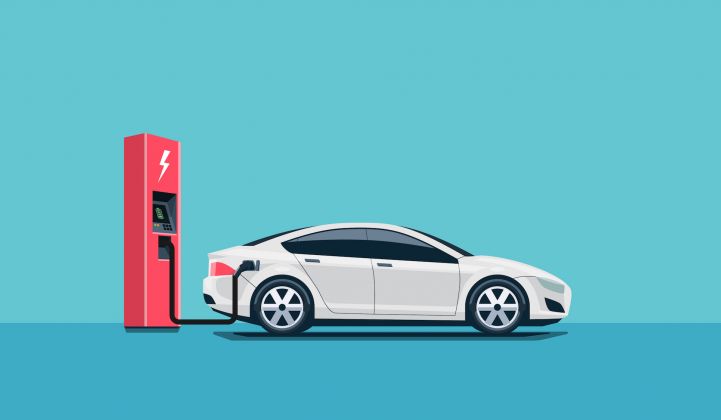In the last two years, nearly everyone has drastically increased their electric vehicle (EV) projections. Oil and gas majors, research organizations, and even car manufacturers are betting that the future is electric, with some automakers such as Volvo and General Motors announcing dramatic production increases for electric cars.
“What people were envisioning would happen three years back by 2030 in a high technology case has already happened. We’re 20 years ahead of time as cost projections go,” said Prajit Ghosh, head of Americas Power and Renewables Research at Wood Mackenzie. “It’s obviously made EVs a lot more attractive.”
Falling lithium-ion battery costs, as well as regulatory pressures in states such as California and countries like France and Norway, have solidified the place of electric vehicles in the car market. “For awhile, there were questions of whether we would be moving to an electrified transportation future,” explained Brett Hauser, CEO at EV charging company Greenlots. “Now I don’t think it’s a matter of if -- it’s a matter of when.”
But with great opportunity comes great challenge. The industry is just beginning to confront how a proliferation of electric vehicles will remake how we drive.
“The first hurdle, I would say, is the infrastructure or the charging needs,” said Ghosh. “It’s a vicious circle, right? You need quick charging to make EVs happen, but that also raises a whole bunch of infrastructure constraints.”
According to Ghosh, the challenge is twofold: making sure the system can supply enough energy to quickly charge a great number of new vehicles and making sure the distribution system is in place to transport those electrons to the right cars at the right time.
He describes the challenge of infrastructure as a chicken-and-egg problem. In order for electric vehicles to dramatically expand, consumers need to have access to charging infrastructure. But before investors are willing to pour large chunks of money into charging, they want to be assured there’s significant demand.
That’s where utilities and traditional oil and gas players come in, according to the electric vehicle industry.
“If you look at the move toward electrified transportation, and how we’re going to get there, we need to have a broad-based deployment and equitable access to infrastructure, irrespective of what kind of house you live in…or whether you’re buying a brand new Tesla or maybe a secondhand Leaf or Volt,” said Hauser. “The organizations that are in the best position to provide that are the utilities, because their mandate is to serve the public interest.”
Hauser said auto manufacturers and utilities working together on infrastructure makes the most sense to provide the best value to customers. Greenlots recently got an unspecified infusion of cash from Energy Impact Partners, a collective of utilities investing in renewable technologies.
That investment, as well as Shell’s recent acquisition of EV charging company NewMotion and Total’s purchase of natural gas and electric charging company Pitpoint, demonstrate that oil and gas majors are beginning to reckon with electrification even if returns are uncertain.
“Personally, from my interactions with Total and Shell all the way up to the highest levels of their senior executives, they thought five years ago, 'Oh, maybe there is an alternative,'” said Brook Porter, a founding partner at G2VP, a spinoff fund from Kleiner Perkins’ Green Growth Fund. “That is not how they view the world today. They have stated that their current business of extracting oil from the ground is a short-term business.”
Joshua Castaneda, a Wood Mackenzie power and renewables analyst, noted that some utilities are experimenting with offering time-of-use rates to incentivize owners to charge their electric vehicle at night. Utilities in states such as California and Washington have also dabbled in rate-basing charging infrastructure. Currently, these programs are small scale, though.
“They need to play a big role, whether it’s oil and gas companies or it’s utilities,” said Ghosh. “Utilities, specifically, need to play a huge role to ensure this infrastructure is adequate from a power supply standpoint as well as a distribution standpoint.”
On the distribution front, consumers will face a shift in how they interact with fueling infrastructure. Filling a tank with gas takes under 10 minutes. Charging a battery that has the hundreds-of-miles range of current vehicles can take between 4 and 8 hours.
“Charging a battery is fundamentally different from filling up gasoline in a car,” said Ghosh. “When you’re charging the battery, you’re basically producing the gasoline right then and there.”
As technology leaps forward, Ghosh said charging in 5 minutes may become a reality. Porter noted that the idea of battery-swapping at fill stations could also take hold. But charging that many vehicles will still require a massive amount of energy.
In a cul-de-sac of 10 homes, for instance, charging vehicles for each residence could double the load, especially at peak hours. Utilities will be tasked with balancing those loads and incentivizing owners to charge at times that don't put excess stress on the grid. Those are the areas where utilities are beginning to pay attention.
“The energy sector is undergoing a transformation unlike anything that has been seen in generations before us,” said Hauser. “Utilities realize they need to get closer to this, if not bleeding-edge, cutting-edge technology and the innovative business models.”
Emma Foehringer Merchant is a staff writer at Greentech Media. She previously covered environmental policy, politics, and climate change at Grist and the New Republic. Emma studied Environmental Analysis at Pomona College.
Emma Foehringer Merchant, Staff writer, GTMedia

